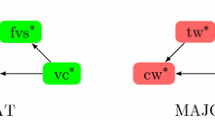Abstract
The model \(k\)-CSP is a random CSP model with moderately growing arity \(k\) of constraints. By incorporating certain linear structure, \(k\)-CSP is revised to a random linear CSP, named \(k\)-hyper-\({\mathbb F}\)-linear CSP. It had been shown theoretically that the two models exhibit exact satisfiability phase transitions when the constraint density \(r\) is varied accordingly. In this paper, we use finite-size scaling analysis to characterize the threshold behaviors of the two models with finite problem size \(n\). A series of experimental studies are carried out to illustrate the scaling window of the model \(k\)-CSP.




Similar content being viewed by others
References
Achlioptas D, Kirousis L, Kranakis E, Krizanc D, Molloy M, Stamatiou Y (1997) Random constraint satisfaction: a more accurate picture. In: Proceedings of the Third International Conference on Principles and Practice of Constraint Programming, LNCS, vol. 1330, pp. 107–120. Springer, Berlin
Achlioptas D, Naor A, Peres Y (2005) \(R\)-matrices and the magic square. Rigorous location of phase transitions in hard optimization problems. Nature 435(7043):759–764
Bollobás B, Borgs C, Chayes JT, Kim JH, Wilson DB (2001) The scaling window of the 2-sat transition. Random Struct Algorithms 18(3):201–256. doi:10.1002/rsa.1006
Chvátal V, Reed B (1992) Miks gets some (the odds are on his side). In: Proceedings of the 33rd IEEE Symposium on Foundations of Computer Science, pp. 620–627. IEEE Computer Society Press, Washington
Crawford J.M, Auton LD (1993) Experimental results on the crossover point in satisfiability problems. In: Proceedings of the Eleventh National Conference on Artificial Intelligence, pp. 21–27
Fan Y, Shen J (2011) On the phase transitions of random k-constraint satisfaction problems. Artif Intell 175:914–927
Fan Y, Shen J, Xu K (2012) A general model and thresholds for random constraint satisfaction problems. Artif Intell 193:1–17
Frieze A, Suen S (1996) Analysis of two simple heuristics on a random instance of k-sat. J Algorithms 20:312–355
Frieze A, Wormald N (2002) Random k-sat: A tight threshold for moderately growing k. In: Proceedings of the Fifth International Symposium on Theory and Applications of Satisfiability Testing, pp. 1–6. Springer, Berlin
Kirkpatrick S, Selman B (1994) Critical behavior in the satisfiability of random boolean formulae. Science 264:1297–1301
Liu T, Wang C, Xu K (2014) Large hypertree width for sparse random hypergraphs. J Comb Optim. doi:10.1007/s10878-013-9704-y
Mitzenmacher M, Upfal E (2005) Probability and computing: randomized algorithm and probabilistic analysis. Cambridge University Press, Cambridge
Molloy M (2001) Models and thresholds for random constraint satisfaction problems. In: Proceedings of the 34th ACM Symposium on Theory of Computing, pp. 209–217. ACM Press, New York
Monasson R, Zecchina R, Kirkpatrick S, Selman B, Troyansky L (1999) 2+p sat: Relation of typical-case complexity to the nature of the phase transition. Random Struct Algorithms 15(3–4):414–435
Smith B, Dyer M (1996) Locating the phase transition in binary constraint satisfaction problems. Artif Intell 81(12):155–181
Xu K, Boussemart F, Hemery F, Lecoutre C (2007) Random constraint satisfaction: easy generation of hard (satisfiable) instances. Artif Intell 171(89):514–534
Xu K, Li W (2000) Exact phase transitions in random constraint satisfaction problems. J Artif Intell Res 12:93–103
Xu K, Li W (2006) Many hard examples in exact phase transitions. Theor Comput Sci 355:291–302
Zhao C, Zheng Z (2011) Threshold behaviors of a random constraint satisfaction problem with exact phase transitions. Inf Process Lett 111(20):985–988. doi:10.1016/j.ipl.2011.07.006.
Zhou G, Gao Z, Liu J (2014) On the constraint length of random k-csp. J Comb Optim. doi:10.1007/s10878-014-9731-3
Acknowledgments
The authors are grateful to Professor Ke Xu from Beihang University for helpful discussions. Many thanks are given to the anonymous reviewers for their valuable comments. This work is supported by the National Natural Science Foundation of China (Grant No. 11171370, 61370052, 61402516).
Author information
Authors and Affiliations
Corresponding author
Rights and permissions
About this article
Cite this article
Shen, J., Ren, Y. Bounding the scaling window of random constraint satisfaction problems. J Comb Optim 31, 786–801 (2016). https://doi.org/10.1007/s10878-014-9789-y
Published:
Issue Date:
DOI: https://doi.org/10.1007/s10878-014-9789-y




